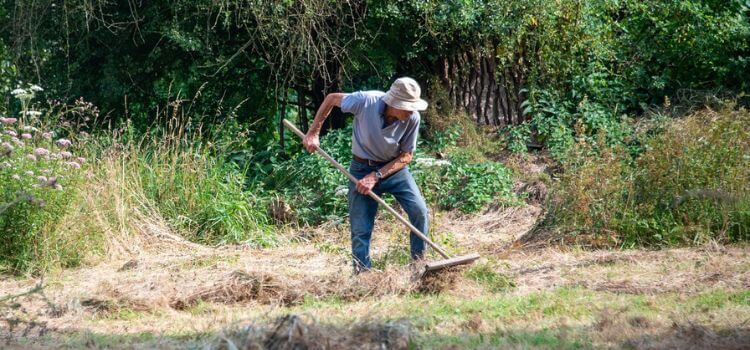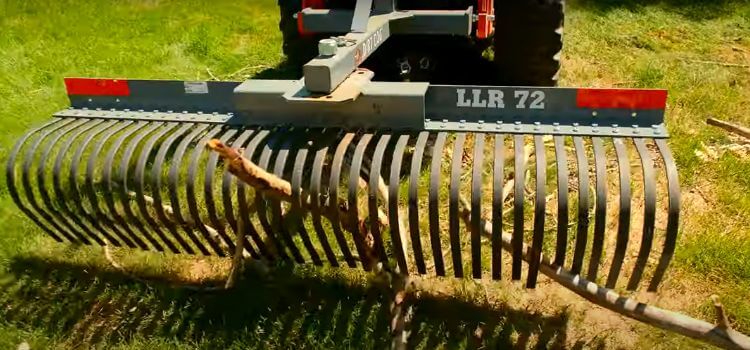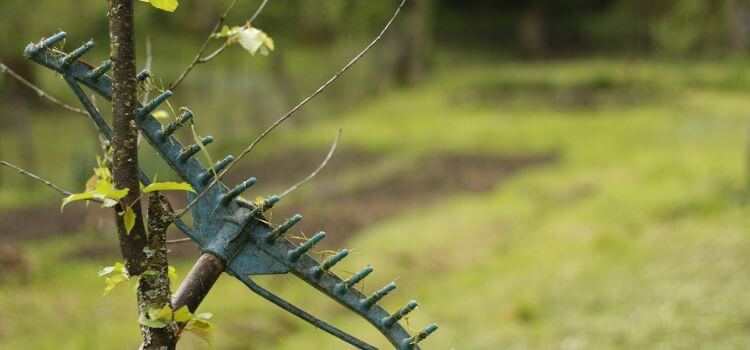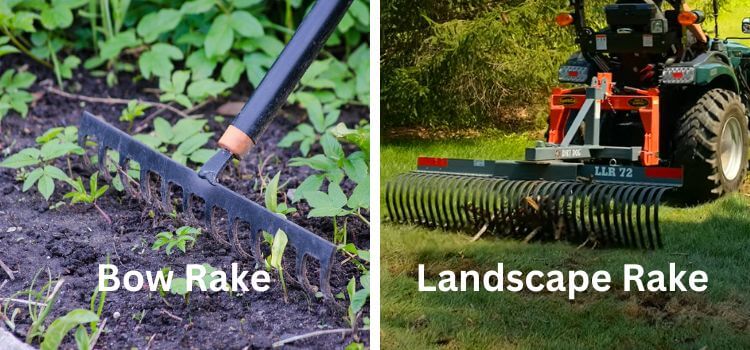As an Amazon Associate, I earn from qualifying purchases.
A bow rake is ideal for moving soil and gravel. A landscape rake is better for levelling and removing debris.
Bow rakes and landscape rakes are essential tools for gardening and landscaping. Bow rakes, featuring shorter, sturdier tines, move and spread heavy materials like soil and gravel. Landscape rakes, with longer and more flexible tines, are perfect for smoothing out soil, removing debris, and creating a fine, even surface.
Choosing the right rake depends on the tasks you must accomplish in your garden or yard. Understanding the differences between these two types of rakes can help you achieve better results and maintain your outdoor spaces more effectively. Investing in the proper tool can save time and effort, ensuring a well-kept and beautiful landscape.
Design And Functionality Compare
Both rakes serve distinct purposes and are uniquely crafted to meet different gardening and landscaping needs.
Bow Rake Design And Features
The bow rake is known for its sturdy design and versatility in the garden. It features a short, straight handle, usually made of wood or metal, providing durability and ease of use. The head of the bow rake consists of a row of short, robust tines, made of steel, that are firmly attached to a crossbar. This crossbar is connected to the handle by two curved supports resembling a bow, hence the name.

Key Features of the Bow Rake:
- Short, strong tines: Ideal for breaking up soil and spreading heavy materials.
- Durable handle: Provides a solid grip and withstands challenging tasks.
- Curved bow design: Offers stability and even distribution of pressure.
Functionality:
- Soil preparation: Perfect for loosening and levelling soil before planting.
- Debris removal: Effective at collecting rocks, roots, and other garden debris.
- Material spreading: You can spread mulch, compost, and gravel evenly.
Landscape Rake Design And Features
The landscape rake is designed for larger-scale tasks and often features a broader head than the bow rake. Its handle is generally longer, providing extended reach and better leverage. The head of the landscape rake usually has more extended, more flexible tines, which can span several feet in width. These tines are often made from lightweight aluminium, making manoeuvring the rake across large areas more accessible.
Key Features of the Landscape Rake:
- Broadhead: Covers more ground, making it efficient for large areas.
- Long handle: Offers greater reach and leverage, reducing the need to bend over.
- Flexible tines: Adapt to uneven surfaces and collect finer debris.

Functionality:
- Levelling soil: Excellent for smoothing out large patches of soil or gravel.
- Clearing debris: Efficient at gathering leaves, grass clippings, and small branches.
- Finishing touches: Ideal for final touches on lawns, gardens, and driveways.
Best Uses For Both Bow Rake and Landscape Rake
Bow rakes and landscape rakes serve different purposes. Knowing their best uses helps achieve the best results in gardening or landscaping projects.
Bow Rake Applications
Bow rakes, or garden rakes, are sturdy and versatile tools. They are best for moving and levelling heavy materials. Critical uses of bow rakes include:
- Levelling Soil: Bow rakes can quickly spread and level soil, making them ideal for preparing garden beds.
- Removing Debris: They effectively remove rocks, roots, and other debris from soil.
- Breaking Up Clumps: The strong tines of a bow rake break up soil clumps, ensuring a smooth surface.
Bow rakes have metal tines that are rigid and spaced evenly. This design makes them excellent for tough jobs. Here is a quick comparison of bow rake features:
Feature | Bow Rake |
Material | Metal tines, wooden or fibreglass handle |
Best For | Heavy-duty tasks |
Weight | Heavier |
Landscape Rake Applications
Landscape rakes, called leaf rakes or lawn rakes, are lightweight and have flexible tines. Critical uses of landscape rakes include:
- Gathering Leaves: Landscape rakes are perfect for collecting leaves and other light debris.
- Smoothing Soil: They can also smooth soil or mulch over large areas.
- Spreading Mulch: These rakes help in evenly spreading mulch or compost.
Landscape rakes are usually made of plastic or metal with flexible tines. This makes them ideal for light and delicate tasks. Here is a quick comparison of landscape rake features:
Feature | Landscape Rake |
Material | Plastic or metal tines, wooden or fibreglass handle |
Best For | Light-duty tasks |
Weight | Lighter |
In summary, landscape rakes are best for light, delicate work. They are ideal for gathering leaves, spreading mulch, and smoothing soil. Their flexible tines make them gentle on plants and lawns.
Pros And Cons of Bow Rake and Landscape Rake
Choosing between a Bow Rake and a Landscape Rake can be challenging. Each rake has unique advantages and disadvantages. Understanding the pros and cons of each will help you make an informed decision.
Pros and Cons Of Bow Rake
Pros
- Bow rakes are made from sturdy materials like steel, making them long-lasting.
- They are perfect for levelling soil and preparing garden beds.
- Bow rakes effectively clear debris, such as rocks and leaves, from the soil.
- The tines of a bow rake can penetrate the soil to help manage roots and weeds.
Cons
- Bow rakes can be heavy, leading to fatigue during prolonged use.
- High-quality bow rakes can be expensive.
- The metal tines can rust if not correctly maintained.
- They must be more suitable for delicate tasks like grooming lawns.
Pros and Cons Of Bow Rake
Pros
- Landscape rakes are often lighter, reducing user fatigue.
- They cover a larger area, which is ideal for spreading gravel and mulch.
- Useful for various tasks, including grading, levelling, and clearing large areas.
- The design makes them easy to handle, even for beginners.
Cons
- Landscape rakes are often made from lighter, less durable materials.
- They are less precise for fine-tuning soil levels as bow rakes.
- Due to their size, they require more storage space.
- High-quality landscape rakes can be costly.
Durability And Maintenance
Bow rakes and landscape rakes serve distinct purposes in gardening and landscaping. Understanding their durability and maintenance needs is crucial.
Durability Of Bow Rake
The bow rake is known for its robust construction. It has a strong metal head attached to a sturdy handle. This ensures it withstands heavy-duty tasks.
Bow rakes often have:
- Steel tines: These are resistant to bending and breaking.
- Wooden or fibreglass handles: These provide durability and comfort.
- Secure attachment: The head is firmly attached to the handle, reducing the risk of detachment.

These features contribute to bow rakes’ longevity. They can handle tough soil, rocks, and debris without significant wear and tear.
Maintenance Of Bow Rake
Maintaining a bow rake ensures its long life. Regular care involves:
- Cleaning: Rinse off dirt and debris after each use.
- Inspection: Check for loose tines or handle cracks.
- Rust prevention: Apply a light coat of oil to the metal parts.
- Storage: Store in a dry place to avoid moisture damage.
Following these steps, you can keep your bow rake in top condition for years.
Durability Of Landscape Rake
The landscape rake is designed to smooth and level large areas. Its construction focuses on flexibility and strength.
Key features include:
- Aluminum or steelhead: Lightweight yet durable.
- Broadhead: Covers more ground in less time.
- Flexible tines: Adapt to the terrain, reducing breakage.
These elements make landscape rakes ideal for extensive landscaping projects. They can withstand frequent use without significant damage.
Maintenance Of Landscape Rake
Proper maintenance of a landscape rake involves:
- Cleaning: Remove dirt and debris after each use.
- Inspection: Look for bent or broken tines.
- Rust prevention: Apply oil to metal parts periodically.
- Handle care: Check for splits or cracks and repair if necessary.
- Storage: Keep it in a dry, sheltered place.
Regular maintenance ensures your landscape rake remains practical and durable.
Price Comparison
Choosing the right rake for your gardening or landscaping tasks can be tricky. Two popular options are the bow rake and the landscape rake. One crucial factor is the cost.
Cost Of Bow Rake
The bow rake is a versatile gardening tool that moves soil, gravel, and other debris. The price of a bow rake depends on the material, brand, and features.
Here is a breakdown of the cost:
- Basic Bow Rake: $10 – $20
- Mid-Range Bow Rake: $20 – $40
- High-End Bow Rake: $40 – $60
Basic bow rakes are made of wood and steel. They are budget-friendly but may need to be more durable. Mid-range bow rakes often have ergonomic handles and are made of more robust materials. High-end bow rakes feature durable construction and extra comfort. They may also have rust-resistant coatings.
Cost Of Landscape Rake
The landscape rake is ideal for larger areas. It is used for levelling soil, spreading mulch, and removing debris. The price of a landscape rake varies based on size, brand, and material.

Here is a breakdown of the cost:
- Basic Landscape Rake: $30 – $50
- Mid-Range Landscape Rake: $50 – $100
- High-End Landscape Rake: $100 – $200
Basic landscape rakes are often more miniature and made of aluminium. They are affordable but may not handle heavy-duty tasks. Mid-range landscape rakes are more robust and have better construction. High-end landscape rakes are built for professional use. They feature heavy-duty materials and larger sizes.
Choose the Right Tool For Your Needs
Choosing between a bow rake and a landscape rake depends on your needs and tasks. Here are some recommendations to consider:
- Task Type: Identify the primary use. A bow rake is better for heavy-duty tasks, while a landscape rake covers large areas.
- Material Handling: Consider the materials you will work with. Bow rakes handle rocks and soil well, whereas landscape rakes are better for leaves and gravel.
- Comfort: Evaluate the tool’s weight and handle design. A comfortable grip reduces fatigue during extended use.
- Precision: A bow rake is preferable for tasks requiring precision, such as garden beds. A landscape rake is more suitable for broader tasks.
Frequently Asked Questions
A bow rake has short, rigid tines and is ideal for heavy-duty tasks like moving soil. A landscape rake has long, flexible tines to spread gravel, sand, or levelling soil.
Bow rakes are good for levelling soil, spreading mulch, and removing debris. They help prepare garden beds and distribute materials evenly.
A landscape rake helps clear debris, level soil, and spread materials like gravel or mulch, improving the aesthetics of gardens and lawns.
Yes, you can rake leaves with a bow rake. However, a leaf rake is more effective for this task.
Conclusion
Choosing between a bow rake and a landscape rake depends on your gardening needs. Bow rakes excel in heavy-duty tasks, while landscape rakes are perfect for lighter, more significant areas. Both tools offer unique benefits. Understanding their uses helps you maintain a beautiful garden.
Make the right choice for your outdoor projects.

